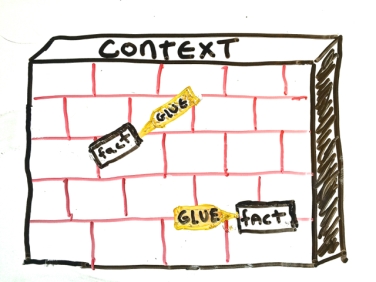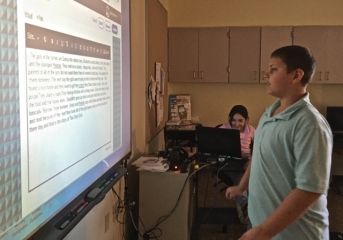Teaching Grammar-In-Context
Archaic Ways of Teaching Grammar
We construct grammatically correct sentences or correct our mistakes by intuitively applying the rules that govern English syntax. If, instead, we had to apply those rules consciously, they would only get in our way, making it impossible for us to speak or write at all. To construct a simple two-word sentence, such as “He dreams,” requires the application of at least seven grammar rules. Imagine trying to apply them consciously following the rules of English grammar.
Over the years, the teaching of grammar has continued to be prominent in English and foreign language instruction, leaving less class time or student energy for students to speak, read, or write in those languages. As early as 1906, studies were undertaken that attempted to show the relationship between knowledge of school-taught grammar and language skills. Since then, hundreds of such studies have produced some clear and unequivocal conclusions: The teaching of formal grammar does not help a student’s ability to speak, to write, to think, or to learn languages.
It is important for educators to know that, among recent research studies, not one justifies teaching grammar to help students write better. Although we accept the fact that social, economic, and political forces influence education in many areas, we ought not to allow such forces to outweigh knowledge and reason in determining the school curriculum. (Is Teaching Grammar Necessary?)
A recent – November, 2017 – research article entitled, Experimental trials and ‘what works?’ in education: The case of grammar for writing, concluded:
With regard to our substantive case of grammar, the current evidence from randomised controlled trials does not support the widespread use of grammar teaching for improving writing among native English-speaking children. Based on the experimental trial and meta-analysis evidence about writing teaching more generally, our hypotheses are that supporting primary/elementary pupils’ grammar is most likely to require teachers intervening during the writing process, and interacting to discuss the use of grammar in relation to the overall purpose of the writing task and the purpose of the writing. Small-group and whole-class teaching that includes a focus on the actual use of grammar in real examples of writing (including professionally produced pieces, realistic examples produced by teachers including ‘think aloud’ live drafting of text and drafts of pupils’ writing) may be more effective.
Learning Needs a Context
I often discuss and blog about teaching content within a context, that learning needs a context. . .
How often have students been asked to memorize mass amounts of facts – historical dates, vocabulary words, science facts; get tested on them, just to forget almost all those memorized facts a week or two later? Given that is this learning experience is more common than not, why do educators insist on continuing this archaic and ineffective instructional practice?
The visual image I use to describe this is that there are all of these unconnected facts floating around in the learner’s brain. Since they have nothing to connect to, they end up flying away. This is especially true for abstract concepts including memorizing grammar rules.
The key to increased understanding is providing a context for the facts and the rules. The context becomes the glue to increase the stickiness, the longevity of long term memory of those facts and rules. This is especially true for abstract concepts such as grammar rules. These concepts need something concrete with which to attach.
Providing a Context for Grammar Instruction
I teach gifted elementary level classes with a good portion of the students being English Language Learners. This translates into ELA grammar making even less sense for them than for English only learners. I do a lot of maker education, STEM (science, technology, engineering, and mathematics), and STEAM (adding arts to it) activities with them, and ask them to document their learning through taking photos and blogging about those activities using their Chromebooks. Because of the article about grammar and talking with the school’s literacy coach, I decided to bring grammar-in-context into my classrooms. How I’ve done this is through projecting individual blog posts onto the Smartboard. The writer of the blog opens his or her blog post in an editing mode. Another learner reads the blog post out loud. The rest of the learners make suggestions for improvement as it is read out loud. I help guide them asking questions like:
- Does that sound right?
- Is that the correct verb for that noun?
- What tense should that verb be?
- What type of punctuation in the different pauses?
- Is that spelling correct?
- Is that possessive? If so, what is the punctuation?
. . . and again, these questions and the suggested edits are done in the context of the individual learners’ blog posts that have already been composed.
Here is an example of one such blog prior to editing:
Some of my observations from this process that I noted includes:
- Learners eagerly volunteer to have their blog posts reviewed. First, they really enjoy having their posts read out loud. Second, I believe this is also due to the focus being on improving their means to communicate better not for a grade.
- The learners know that their blogs are viewed by their own classmates and their sister school (I teach gifted education at two schools and have opened my Kidblog to both schools to view one another’s posts). They have authentic audiences and what to present their best selves.
- As it becomes a group exercise, the other class members seem to enjoy the challenge and become engaged in offering corrections and improvements.
- To keep up the motivation and make it manageable, I only do 2 or 3 during any giving sitting.
An Engagement Story
Update: This is the second year that I am continuing this practice with my gifted elementary learners. I have a student who dislikes the hands-on activities I do in my class. Since I do so many of them, I often struggle to find ways to engage him. One of his strengths is writing and grammar. I’ve made him the “official” grammar coach helping the other learners edit their blog posts. When he is doing so, he definitely finds his stride; a purpose in my class.


He work with an English language learner to help her edit her blog post. Both learners were highly engaged in this process,
Here is the before:
 . . and here is the after:
. . and here is the after:

Not perfect, but better, and I believe they both learned from the process.


Great article. Love your emphasis on context. I always emphasise that too. I especially agree with this: The teaching of formal grammar does not help a student’s ability to speak, to write, to think, or to learn languages.
I wish more teachers would take note of its truth.
Norah
October 15, 2016 at 11:15 am
Thanks, Norah!
Jackie Gerstein, Ed.D.
October 15, 2016 at 12:15 pm
So true. We had a compulsory grammar test last week. Despite poor reading age for most of my kids, reminding them that they only had to think how a sentence sounds (say it/write) removed the paralysis of answering the questions.
aspire2hopegm
October 16, 2016 at 4:28 pm
I love the drawing to illustrate this idea, and didn’t know that teaching grammar 🙂 Reminds me of the Tony Wagner book “Most Likely To Succeed” chapter on high school AP tests in this regard. It mentions studies done where students who got 5s (top score) re-took the same AP test 3 months later and couldn’t pass it – that’s how many facts flew away…
paulanz
October 26, 2016 at 6:26 pm